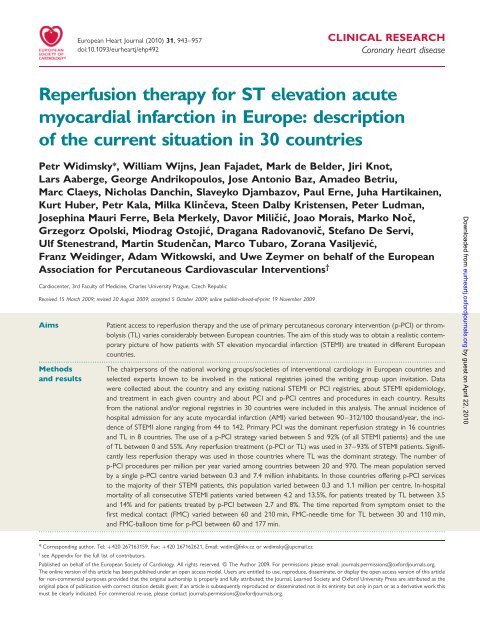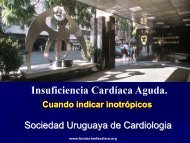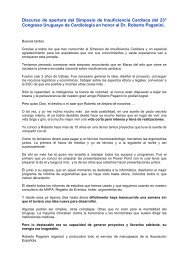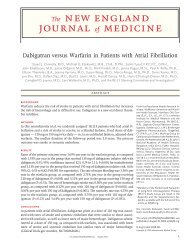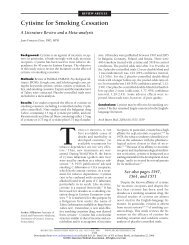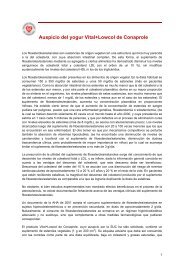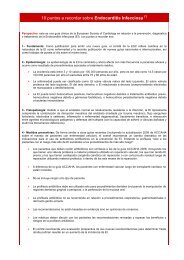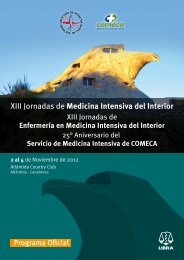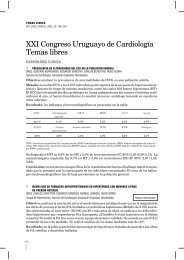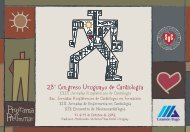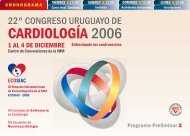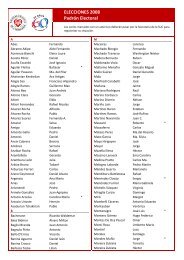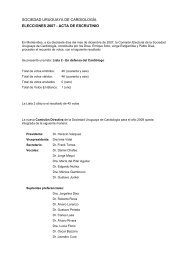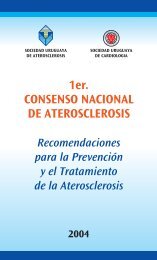Reperfusion therapy for ST elevation acute myocardial infarction in ...
Reperfusion therapy for ST elevation acute myocardial infarction in ...
Reperfusion therapy for ST elevation acute myocardial infarction in ...
Create successful ePaper yourself
Turn your PDF publications into a flip-book with our unique Google optimized e-Paper software.
European Heart Journal (2010) 31, 943–957<br />
doi:10.1093/eurheartj/ehp492<br />
CLINICAL RESEARCH<br />
Coronary heart disease<br />
<strong>Reperfusion</strong> <strong>therapy</strong> <strong>for</strong> <strong>ST</strong> <strong>elevation</strong> <strong>acute</strong><br />
<strong>myocardial</strong> <strong><strong>in</strong>farction</strong> <strong>in</strong> Europe: description<br />
ofthecurrentsituation<strong>in</strong>30countries<br />
Petr Widimsky*, William Wijns, Jean Fajadet, Mark de Belder, Jiri Knot,<br />
Lars Aaberge, George Andrikopoulos, Jose Antonio Baz, Amadeo Betriu,<br />
Marc Claeys, Nicholas Danch<strong>in</strong>, Slaveyko Djambazov, Paul Erne, Juha Hartika<strong>in</strong>en,<br />
Kurt Huber, Petr Kala, Milka Kl<strong>in</strong>čeva, Steen Dalby Kristensen, Peter Ludman,<br />
Joseph<strong>in</strong>a Mauri Ferre, Bela Merkely, Davor Miličić, Joao Morais, Marko Noč,<br />
Grzegorz Opolski, Miodrag Ostojić, Dragana Radovanovič, Stefano De Servi,<br />
Ulf Stenestrand, Mart<strong>in</strong> Studenčan, Marco Tubaro, Zorana Vasiljević,<br />
Franz Weid<strong>in</strong>ger, Adam Witkowski, and Uwe Zeymer on behalf of the European<br />
Association <strong>for</strong> Percutaneous Cardiovascular Interventions †<br />
Cardiocenter, 3rd Faculty of Medic<strong>in</strong>e, Charles University Prague, Czech Republic<br />
Received 15 March 2009; revised 20 August 2009; accepted 5 October 2009; onl<strong>in</strong>e publish-ahead-of-pr<strong>in</strong>t 19 November 2009<br />
Aims<br />
Patient access to reperfusion <strong>therapy</strong> and the use of primary percutaneous coronary <strong>in</strong>tervention (p-PCI) or thrombolysis<br />
(TL) varies considerably between European countries. The aim of this study was to obta<strong>in</strong> a realistic contemporary<br />
picture of how patients with <strong>ST</strong> <strong>elevation</strong> <strong>myocardial</strong> <strong><strong>in</strong>farction</strong> (<strong>ST</strong>EMI) are treated <strong>in</strong> different European<br />
countries.<br />
.....................................................................................................................................................................................<br />
Methods The chairpersons of the national work<strong>in</strong>g groups/societies of <strong>in</strong>terventional cardiology <strong>in</strong> European countries and<br />
and results selected experts known to be <strong>in</strong>volved <strong>in</strong> the national registries jo<strong>in</strong>ed the writ<strong>in</strong>g group upon <strong>in</strong>vitation. Data<br />
were collected about the country and any exist<strong>in</strong>g national <strong>ST</strong>EMI or PCI registries, about <strong>ST</strong>EMI epidemiology,<br />
and treatment <strong>in</strong> each given country and about PCI and p-PCI centres and procedures <strong>in</strong> each country. Results<br />
from the national and/or regional registries <strong>in</strong> 30 countries were <strong>in</strong>cluded <strong>in</strong> this analysis. The annual <strong>in</strong>cidence of<br />
hospital admission <strong>for</strong> any <strong>acute</strong> <strong>myocardial</strong> <strong><strong>in</strong>farction</strong> (AMI) varied between 90–312/100 thousand/year, the <strong>in</strong>cidence<br />
of <strong>ST</strong>EMI alone rang<strong>in</strong>g from 44 to 142. Primary PCI was the dom<strong>in</strong>ant reperfusion strategy <strong>in</strong> 16 countries<br />
and TL <strong>in</strong> 8 countries. The use of a p-PCI strategy varied between 5 and 92% (of all <strong>ST</strong>EMI patients) and the use<br />
of TL between 0 and 55%. Any reperfusion treatment (p-PCI or TL) was used <strong>in</strong> 37–93% of <strong>ST</strong>EMI patients. Significantly<br />
less reperfusion <strong>therapy</strong> was used <strong>in</strong> those countries where TL was the dom<strong>in</strong>ant strategy. The number of<br />
p-PCI procedures per million per year varied among countries between 20 and 970. The mean population served<br />
by a s<strong>in</strong>gle p-PCI centre varied between 0.3 and 7.4 million <strong>in</strong>habitants. In those countries offer<strong>in</strong>g p-PCI services<br />
to the majority of their <strong>ST</strong>EMI patients, this population varied between 0.3 and 1.1 million per centre. In-hospital<br />
mortality of all consecutive <strong>ST</strong>EMI patients varied between 4.2 and 13.5%, <strong>for</strong> patients treated by TL between 3.5<br />
and 14% and <strong>for</strong> patients treated by p-PCI between 2.7 and 8%. The time reported from symptom onset to the<br />
first medical contact (FMC) varied between 60 and 210 m<strong>in</strong>, FMC-needle time <strong>for</strong> TL between 30 and 110 m<strong>in</strong>,<br />
and FMC-balloon time <strong>for</strong> p-PCI between 60 and 177 m<strong>in</strong>.<br />
.....................................................................................................................................................................................<br />
Downloaded from eurheartj.ox<strong>for</strong>djournals.org by guest on April 22, 2010<br />
* Correspond<strong>in</strong>g author. Tel: þ420 267163159, Fax: þ420 267162621, Email: widim@fnkv.cz or widimsky@upcmail.cz<br />
†<br />
see Appendix <strong>for</strong> the full list of contributors.<br />
Published on behalf of the European Society of Cardiology. All rights reserved. & The Author 2009. For permissions please email: journals.permissions@ox<strong>for</strong>djournals.org.<br />
The onl<strong>in</strong>e version of this article has been published under an open access model. Users are entitled to use, reproduce, dissem<strong>in</strong>ate, or display the open access version of this article<br />
<strong>for</strong> non-commercial purposes provided that the orig<strong>in</strong>al authorship is properly and fully attributed; the Journal, Learned Society and Ox<strong>for</strong>d University Press are attributed as the<br />
orig<strong>in</strong>al place of publication with correct citation details given; if an article is subsequently reproduced or dissem<strong>in</strong>ated not <strong>in</strong> its entirety but only <strong>in</strong> part or as a derivative work this<br />
must be clearly <strong>in</strong>dicated. For commercial re-use, please contact journals.permissions@ox<strong>for</strong>djournals.org.
944<br />
P. Widimsky et al.<br />
Conclusion<br />
Most North, West, and Central European countries used p-PCI <strong>for</strong> the majority of their <strong>ST</strong>EMI patients. The lack of<br />
organized p-PCI networks was associated with fewer patients overall receiv<strong>in</strong>g some <strong>for</strong>m of reperfusion <strong>therapy</strong>.<br />
-----------------------------------------------------------------------------------------------------------------------------------------------------------<br />
Keywords<br />
Acute <strong>myocardial</strong> <strong><strong>in</strong>farction</strong> † <strong>Reperfusion</strong> <strong>therapy</strong> † Thrombolysis † Primary angioplasty † Europe † Mortality<br />
† Incidence<br />
Introduction<br />
Primary percutaneous coronary <strong>in</strong>tervention (PCI) and thrombolysis<br />
(TL) represent two alternative reperfusion strategies <strong>for</strong> <strong>ST</strong><br />
<strong>elevation</strong> <strong>acute</strong> <strong>myocardial</strong> <strong><strong>in</strong>farction</strong> (<strong>ST</strong>EMI). In common, TL is<br />
considered to be more widely available and can be started faster<br />
than primary PCI. In many randomized cl<strong>in</strong>ical trials, 1–6 primary<br />
PCI has been shown to be superior to TL <strong>in</strong> reduc<strong>in</strong>g mortality,<br />
re-<strong><strong>in</strong>farction</strong>, and stroke. This benefit is related to a much higher<br />
early mechanical reperfusion rate (ca. 90%) compared with<br />
pharmacological reperfusion rate (ca. 50%), to the ability of simultaneously<br />
treat<strong>in</strong>g the underly<strong>in</strong>g stenosis and f<strong>in</strong>ally to the lower<br />
risk of severe bleed<strong>in</strong>g. The most recent European Society of Cardiology<br />
(ESC) guidel<strong>in</strong>es 7,8 recommend primary PCI as the preferred<br />
treatment whenever it is available with<strong>in</strong> 90–120 m<strong>in</strong> of<br />
the first medical contact (FMC). The aim of this project was to<br />
analyse the use of reperfusion treatments across Europe at the<br />
time when these new ESC guidel<strong>in</strong>es were published.<br />
Methods<br />
The European Association <strong>for</strong> Percutaneous Cardiovascular Interventions<br />
(EAPCI) <strong>in</strong>vited the chairpersons of the national work<strong>in</strong>g groups/<br />
societies of <strong>in</strong>terventional cardiology <strong>in</strong> all 51 European Society of Cardiology<br />
(ESC) countries and selected experts known to be <strong>in</strong>volved <strong>in</strong><br />
the national registries of <strong>ST</strong>EMI to jo<strong>in</strong> this project. Positive replies<br />
were received from 30 countries. Data were collected about the<br />
country and any exist<strong>in</strong>g national <strong>ST</strong>EMI or PCI registries, about<br />
<strong>ST</strong>EMI hospital admissions and treatment <strong>in</strong> each given country, and<br />
about PCI and primary PCI centres and procedures <strong>in</strong> each country.<br />
Specifically, each participat<strong>in</strong>g national work<strong>in</strong>g group (or society) provided<br />
the precise number of all exist<strong>in</strong>g PCI hospitals <strong>in</strong> the given country<br />
and how many of them offer non-stop (24/7) primary PCI services.<br />
Primary PCI centre (24/7) was def<strong>in</strong>ed as PCI hospital not us<strong>in</strong>g TL<br />
<strong>for</strong> the treatment of <strong>ST</strong>EMI patients, <strong>in</strong> other words hospital per<strong>for</strong>m<strong>in</strong>g<br />
primary PCI <strong>in</strong> all <strong>ST</strong>EMI patients, 24 h/day and 7 days/week.<br />
Results from 30 European countries were <strong>in</strong>cluded <strong>in</strong> this analysis<br />
(Tables 1 and 2). These data reflect the situation <strong>in</strong> years 2007–<br />
2008 <strong>for</strong> most countries, but <strong>in</strong> 2006 or 2005 <strong>for</strong> a few, <strong>in</strong> whom<br />
the most recent data were not available.<br />
Those national data already published are listed <strong>in</strong> the references<br />
section 9–27 and the names of ongo<strong>in</strong>g registries and/or surveys are<br />
listed <strong>in</strong> the appendix and more details <strong>in</strong> Table 1.<br />
Besides obta<strong>in</strong><strong>in</strong>g the numbers from the <strong>in</strong>dividual countries, the contributors<br />
were also asked to describe subjectively, what they consider to be<br />
the ma<strong>in</strong> barriers <strong>for</strong> better p-PCI implementation and to comment on the<br />
possible <strong>in</strong>fluence of hospital/staff reimbursement on the local situation.<br />
Statistical analysis<br />
Data are presented <strong>in</strong> the descriptive <strong>for</strong>mat as we received them<br />
from each <strong>in</strong>dividual country (see appendix <strong>for</strong> the list of contributors).<br />
The SPSS 12.0 statistical package was used to fit the l<strong>in</strong>ear regression<br />
l<strong>in</strong>es.<br />
Results<br />
Annual <strong>in</strong>cidence of hospital admission<br />
<strong>for</strong> <strong>acute</strong> <strong>myocardial</strong> <strong><strong>in</strong>farction</strong><br />
The annual <strong>in</strong>cidence of hospital admission <strong>for</strong> any <strong>acute</strong> <strong>myocardial</strong><br />
<strong><strong>in</strong>farction</strong> (AMI) varied between 90–312/100 000 <strong>in</strong>habitants/year<br />
and the <strong>in</strong>cidence of hospital admissions <strong>for</strong> <strong>ST</strong>EMI<br />
alone between 44–142/100 000 <strong>in</strong>habitants/year (Table 2).<br />
<strong>Reperfusion</strong> strategy use<br />
Primary PCI is the dom<strong>in</strong>ant reperfusion strategy <strong>in</strong> 16 countries<br />
and TL <strong>in</strong> 8 countries. From five countries (Denmark, Estonia,<br />
Lithuania, Norway, and Spa<strong>in</strong>), only <strong>in</strong><strong>for</strong>mation about primary<br />
PCI (and not about TL) was available. The use of a p-PCI strategy<br />
varies between 5 and 92% (of all <strong>ST</strong>EMI patients) and the use of TL<br />
between 0 and 55%. Any reperfusion treatment (p-PCI or TL) is<br />
used <strong>in</strong> 37–93% of <strong>ST</strong>EMI patients (Figure 1). Overall, <strong>in</strong> those<br />
countries us<strong>in</strong>g TL as the dom<strong>in</strong>ant strategy, the overall population<br />
receiv<strong>in</strong>g some <strong>for</strong>m of reperfusion <strong>therapy</strong> is lower (only 55%<br />
patients are treated, although this varied considerably from<br />
country to country).<br />
The population need <strong>for</strong> primary<br />
PCI services<br />
The number of primary PCI procedures per 100 000 <strong>in</strong>habitants<br />
per year (Table 3; Figure 2) ranged from 2 to 97. The mean population<br />
served by a s<strong>in</strong>gle p-PCI centre (Table 4) varies between 0.3<br />
and 7.4 million <strong>in</strong>habitants. In those countries offer<strong>in</strong>g p-PCI services<br />
to the majority of their <strong>ST</strong>EMI patients, this population<br />
varies between 0.3 and 1.1 million per centre. There was a weak<br />
correlation between numbers of PCI procedures and the gross<br />
domestic product per capita (Figure 3; Table 3).<br />
Mortality<br />
The <strong>in</strong>-hospital mortality of all consecutive <strong>ST</strong>EMI patients<br />
(Table 5) varies between 4.2 and 13.5%, <strong>for</strong> patients treated by<br />
TL between 3.5 and 14%, and <strong>for</strong> patients treated by primary<br />
PCI between 2.7 and 8%.<br />
Time delays<br />
The time from symptom onset to the FMC (def<strong>in</strong>ed as the time of<br />
diagnostic ECG) ranged from 60 to 210 m<strong>in</strong>, FMC-needle time <strong>for</strong><br />
TL between 30 and 110 m<strong>in</strong> and FMC-balloon time <strong>for</strong> p-PCI<br />
between 60 and 177 m<strong>in</strong>. These FMC-balloon times are given <strong>for</strong><br />
all primary PCI procedures, irrespective of whether the patient<br />
Downloaded from eurheartj.ox<strong>for</strong>djournals.org by guest on April 22, 2010
Table 1<br />
National registries and other sources of the countries’ data <strong>for</strong> this study<br />
Country Year <strong>ST</strong>EMI registry (name) PCI registry (name) Other registry or survey (name) Expert Completeness of <strong>ST</strong>EMI<br />
estimate only captur<strong>in</strong>g per period and<br />
region<br />
.............................................................................................................................................................................................................................................<br />
Austria 2005–07 VIENNA <strong>ST</strong>EMI registry 34 Austrian Heart Catheter Registry 36 Austrian Acute PCI Registry 37 – 100% <strong>in</strong> Vienna region, ca. 50% <strong>for</strong><br />
Austria<br />
Belgium 2008 Belgian <strong>ST</strong>EMI registry Belgian Work<strong>in</strong>g Group Interventional<br />
50%<br />
Cardiology registry<br />
Bulgaria 2007 National Health Insurance Fund National Health Insurance Fund, Bulgarian – – 100%<br />
WG Interventional Cardiology<br />
90% <strong>for</strong> <strong>ST</strong>EMI; 100% <strong>for</strong> PCI<br />
Croatia 2005–08 Croatian Cardiac Society, WG<br />
<strong>for</strong> Acute Coronary<br />
Syndromes<br />
Croatian Cardiac Society; Hospital PCI<br />
Registries<br />
Zagreb AMI Registry; Croatian<br />
Institute of Public Health<br />
Czech Republic 2005–07 CZECH registry (all ACS) 19 NRKI registry – – 100% <strong>for</strong> all ACS <strong>in</strong> the CZECH<br />
registry<br />
Denmark 2007 None Danish Heart Registry – For AMI not 100% <strong>for</strong> p-PCI<br />
undergo<strong>in</strong>g PCI<br />
Estonia 2008 Estonian Myocardial Infarction – – – 100%<br />
Registry, WG on Acute<br />
Coronary Syndromes<br />
France 2005 FA<strong>ST</strong>-MI 33 FAR – – 60% of ICUs<br />
F<strong>in</strong>land 2006 – – Registry of Cardiovascular Diseases, – ca. 90% <strong>for</strong> all AMI<br />
Welfare 18<br />
National Institute <strong>for</strong> Health and<br />
Germany 2007–08 German Myocardial <strong><strong>in</strong>farction</strong> – Herzbericht 2007 47 – 25%<br />
registry 46<br />
Greece 2006 HELIOS 14,16 – Hellenic Study of AMI 15 – 100%<br />
Hungary 2004–08 National Health Insurance<br />
Database<br />
Italy 2006–08 VENERE, 41 In-ACS (2007); BLITZ<br />
3 (2008)<br />
Registry of the Work<strong>in</strong>g Group of<br />
Interventional Cardiology<br />
GISE Registry (GISE¼Italian Society of<br />
Interventional Cardiology)<br />
PCI Network <strong>in</strong> the Middle-Hungarian<br />
region (Budapest)<br />
– 100% <strong>for</strong> all<br />
Istituto Superiore di Sanità (ISS) – 100% <strong>in</strong> Veneto Region; p-PCI<br />
100% <strong>in</strong> GISE (all Italy); 80% <strong>in</strong><br />
BLITZ 3<br />
Israel 2006 ACSIS – – – 100%<br />
Latvia 2008 Latvian registry of <strong>acute</strong> coronary Latvian registry of <strong>acute</strong> coronary syndromes – – 100%<br />
syndromes<br />
Lithuania 2007–08 – Lithuanian PCI registry – Yes <strong>for</strong> AMIs<br />
without PCI<br />
100% <strong>for</strong> p-PCI only<br />
F.Y.R. Macedonia 2007–08 – Hospital based registries <strong>in</strong> all exist<strong>in</strong>g PCI<br />
centres<br />
– – 95% <strong>in</strong> Skopje, ca. 80% <strong>for</strong><br />
Macedonia<br />
The Netherlands 2008 – Dutch National PCI Registry (BHN) – – –<br />
Norway 2007 – PCI-hospital based registries – For patients not<br />
treated by PCI<br />
Not known (PCI data only)<br />
Cont<strong>in</strong>ued<br />
<strong>Reperfusion</strong> <strong>therapy</strong> <strong>for</strong> <strong>ST</strong>EMI <strong>in</strong> Europe 945<br />
Downloaded from eurheartj.ox<strong>for</strong>djournals.org by guest on April 22, 2010
946<br />
Table 1 Cont<strong>in</strong>ued<br />
–<br />
Country Year <strong>ST</strong>EMI registry (name) PCI registry (name) Other registry or survey (name) Expert Completeness of <strong>ST</strong>EMI<br />
estimate only captur<strong>in</strong>g per period and<br />
region<br />
.............................................................................................................................................................................................................................................<br />
Poland 2004–07 PL-ASC Registry PCI registry of the WG on Cardiovascular<br />
– 100%<br />
Interventions of the Polish Cardiac<br />
Society<br />
Portugal 2008 National ACS Registry 2002, 43 – – N.A.<br />
updated 2009 44<br />
Romania 2007–08 RO-<strong>ST</strong>EMI – – – 100%<br />
Serbia 2007 National Institute <strong>for</strong> Health Work<strong>in</strong>g group on <strong>in</strong>terventional<br />
100%<br />
cardiology 42<br />
Slovakia 2007 SLOVAKS registry Registry of the Work<strong>in</strong>g Group<br />
Interventional Cardiology (Slovak Society<br />
of Cardiology)<br />
– – 46% of all <strong>ST</strong>EMI and 100% of<br />
p-PCI <strong>in</strong> Slovakia<br />
Slovenia 2007 National survey National survey – – 100%<br />
Spa<strong>in</strong> 2007 – Registro Español de Hemod<strong>in</strong>ámica y – Yes <strong>for</strong> AMIs N.A.<br />
Cardiología Intervencionista 45 without PCI<br />
Sweden 2007 RIKS-HIA SCAAR – – 100%<br />
Switzerland 2007 AMIS Plus (<strong>ST</strong>EMI/N<strong>ST</strong>EMI/UA Swiss PCI survey 51 – – 100% <strong>for</strong> p-PCI, 43% <strong>for</strong> <strong>ST</strong>EMIs<br />
registry 48 – 50 )<br />
Turkey 2007 TUMAR registry – – Yes, partly N.A.<br />
UK 2005–08 Myocardial Ischaemia National<br />
Audit Project (MINAP) 38<br />
British Cardiovascular Intervention Society – – 100%<br />
database (CCAD) 40<br />
(BCIS) 39 and Central Cardiac Audit<br />
P. Widimsky et al.<br />
Downloaded from eurheartj.ox<strong>for</strong>djournals.org by guest on April 22, 2010
<strong>Reperfusion</strong> <strong>therapy</strong> <strong>for</strong> <strong>ST</strong>EMI <strong>in</strong> Europe 947<br />
Table 2<br />
Population data and <strong>acute</strong> <strong>myocardial</strong> <strong><strong>in</strong>farction</strong> annual <strong>in</strong>cidence<br />
Country<br />
Country population (www. Hospitalized <strong>ST</strong>EMI/100 Hospitalized AMI/100<br />
populationmondiale.com) <strong>ST</strong>EMI/year thousand/year AMI (any) thousand/year<br />
...............................................................................................................................................................................<br />
Austria 8 199 783 7800 95 16 000 195<br />
Belgium 10 584 534 7000 66 12 000 114<br />
Bulgaria 7 640 238 8726 114 11 285 148<br />
Croatia 4 493 312 3600 82 N.A. N.A.<br />
Czech Republic 10 228 744 6761 66 20 048 196<br />
Denmark 5 468 120 N.A. N.A. N.A. N.A.<br />
Estonia 1 315 912 1751 133 3502 266<br />
France 62 448 977 35 000 55 65 000 105<br />
F<strong>in</strong>land 5 300 484 4674 88 16 446 310<br />
Germany 82 217 837 100 000 121 208 000 250<br />
Greece 10 706 290 11 780 110 19 853 185<br />
Hungary 9 956 108 8900 89 18 500 186<br />
Italy 58 147 733 67 500 116 147.500 254<br />
Israel 7 337 000 5500 75 10 000 136<br />
Latvia 2 270 894 1437 63 N.A. N.A.<br />
Lithuania 3 575 439 3000 84 N.A. N.A.<br />
F.Y.R. Macedonia 2 049 613 1765 86 N.A. N.A.<br />
The Netherlands 16 405 399 N.A. N.A. N.A. N.A.<br />
Norway 4 703 779 3900 83 12 650 276<br />
Poland 38 518 241 50 000 130 90 000 234<br />
Portugal 10 642 836 11 104 104 N.A. N.A.<br />
Romania 22 276 056 10 000 45 20 000 90<br />
Serbia 7 400 000 6079 82 8655 117<br />
Slovakia 5 447 522 3635 67 7635 140<br />
Slovenia 2 009 245 1210 60 N.A. N.A.<br />
Spa<strong>in</strong> 45 116 894 40 000 89 120 000 266<br />
Sweden 9 031 088 6000 66 21 000 232<br />
Switzerland 7 593 494 N.A. N.A. 11 337 149<br />
Turkey 70 586 256 100 000 142 220 000 312<br />
UK 60 776 238 27 000 44 105 000 173<br />
<strong>ST</strong>EMI, <strong>ST</strong> <strong>elevation</strong> <strong>acute</strong> <strong>myocardial</strong> <strong><strong>in</strong>farction</strong>; AMI, <strong>acute</strong> <strong>myocardial</strong> <strong><strong>in</strong>farction</strong>, N.A., not available.<br />
Downloaded from eurheartj.ox<strong>for</strong>djournals.org by guest on April 22, 2010<br />
underwent <strong>in</strong>terhospital transfer or was directly admitted to the<br />
PCI hospital (Table 6; Figures 4 and 5).<br />
<strong>ST</strong>EMI <strong>in</strong>itial presentation<br />
Only approximately half of the patients arrive at the hospital via an<br />
EMS ambulance. This proportion varies considerably between<br />
countries: from 17% (Greece) to 85% (UK) (Figure 6).<br />
Discussion<br />
Geographic differences, heterogenity<br />
of care<br />
Primary PCI appears to be now the dom<strong>in</strong>ant treatment of <strong>ST</strong>EMI<br />
<strong>in</strong> the majority of countries: Scand<strong>in</strong>avia (Norway, Denmark,<br />
Sweden, and F<strong>in</strong>land), Central Europe (Czech Republic, Slovenia,<br />
Poland, Hungary, Austria, and Croatia), West Europe (Germany,<br />
Belgium, France, Switzerland, and the Netherlands), Italy, and<br />
Israel. Several countries have the <strong>in</strong>frastructure available, but do<br />
not use it sufficiently to treat most of their AMI patients—this<br />
holds true especially <strong>for</strong> the South Europe (Greece, Bulgaria,<br />
Portugal, Spa<strong>in</strong>, and Turkey) and <strong>for</strong> the UK and Slovakia<br />
(however, national programs <strong>for</strong> p-PCI implementation have<br />
already started <strong>in</strong> these latter two countries). The described<br />
‘North-South gradient’ <strong>in</strong> primary PCI services is typically seen<br />
<strong>in</strong> Italy: the Northern part of Italy has p-PCI rates similar to<br />
Central or West Europe, while the Southern part of Italy has<br />
rates similar to Greece or Turkey. Un<strong>for</strong>tunately, no or few<br />
data have been obta<strong>in</strong>ed from Ireland, Iceland, East Europe<br />
(Belarus, Ukra<strong>in</strong>a, Russia, Moldova, Bosnia i Herzegov<strong>in</strong>a,<br />
FYROM, Albania, and Georgia) and from the Mediterranean<br />
non-European countries (ESC members).<br />
The heterogeneity of care is known from <strong>in</strong>ternational<br />
registries—e.g. the GRACE registry showed that the care-seek<strong>in</strong>g
948<br />
P. Widimsky et al.<br />
Figure 1 Hospitalized <strong>ST</strong>EMI treatment <strong>in</strong> Europe (data from national registries or surveys). 100%, all hospitalized <strong>ST</strong>EMI patients <strong>in</strong> each<br />
given country; green colour, <strong>ST</strong>EMI patients treated by primary PCI; red colour, <strong>ST</strong>EMI patients treated by thrombolysis; black colour,<br />
<strong>ST</strong>EMI patients not treated with any reperfusion. Countries abbreviations: CZ, Czech Republic; SLO, Slovenia; DE, Germany; CH, Switzerland;<br />
PL, Poland; HR, Croatia; SE, Sweden; HU, Hungary; BE, Belgium; IL, Israel; IT, Italy; FIN, F<strong>in</strong>land; AT, Austria; FR, France; SK, Slovakia; LAT, Latvia;<br />
UK, United K<strong>in</strong>gdom; BG, Bulgaria; PO, Portugal; SRB, Serbia; GR, Greece; TR, Turkey; RO, Romania.<br />
behaviour <strong>in</strong> patients with <strong>acute</strong> coronary disease differs among<br />
countries or cont<strong>in</strong>ents. 28<br />
Annual <strong>in</strong>cidence of the hospital<br />
admissions <strong>for</strong> <strong>acute</strong> <strong>myocardial</strong><br />
<strong><strong>in</strong>farction</strong><br />
The annual <strong>in</strong>cidence of hospital admission <strong>for</strong> any AMI varied considerably,<br />
as was the case <strong>for</strong> the <strong>in</strong>cidence of <strong>ST</strong>EMI alone. Those<br />
countries with the most precise data (e.g. cover<strong>in</strong>g 100% of the<br />
population either <strong>in</strong> the whole country or <strong>in</strong> selected regions/<br />
counties—see Table 1) reported the <strong>in</strong>cidence close to the<br />
overall mean numbers (ca. 1900 <strong>for</strong> all AMIs and ca. 800 <strong>for</strong><br />
<strong>ST</strong>EMIs). In other words, the annual <strong>in</strong>cidence of ca. 1900 hospital<br />
admissions <strong>for</strong> any AMI per year per million population seems to<br />
be typical <strong>for</strong> the European population. This can be used <strong>for</strong> plann<strong>in</strong>g<br />
<strong>in</strong>frastructure because most of these patients will need coronary<br />
angiography and subsequent PCI or CABG dur<strong>in</strong>g their<br />
hospital stay.<br />
<strong>Reperfusion</strong> strategy use<br />
It is of note that primary PCI is already today the lead<strong>in</strong>g reperfusion<br />
strategy <strong>in</strong> most European countries. Several countries can<br />
serve as evidence that p-PCI may be able to be offered to as<br />
many as 70–90% of all <strong>ST</strong>EMI patients <strong>in</strong> the whole country. An<br />
<strong>in</strong>creased use of primary PCI as the preferred reperfusion<br />
<strong>therapy</strong> is identified by this data when compared with the<br />
second Euro Heart Survey on Acute Coronary Syndromes<br />
(EHS-ACS-II). 29 Results of our study challenge the traditional<br />
op<strong>in</strong>ion that TL is the strategy more suitable <strong>for</strong> widespread application.<br />
In some countries, the opposite appears to be true: reperfusion<br />
as a whole is offered to less of the <strong>ST</strong>EMI population <strong>in</strong><br />
those countries us<strong>in</strong>g TL as the dom<strong>in</strong>ant strategy. This may be<br />
related to the many contra<strong>in</strong>dications <strong>for</strong> thrombolytic <strong>therapy</strong><br />
and also to the fear of us<strong>in</strong>g TL <strong>in</strong> patients over 75 years of age,<br />
who present a significant proportion of all <strong>ST</strong>EMI patients today<br />
(e.g. 31% of all hospitalized AMI patients <strong>in</strong> the Netherlands 30 ).<br />
Thus p-PCI, despite its logistic complexity, appears to offer<br />
broader population reach <strong>in</strong> some countries.<br />
The population need <strong>for</strong> primary PCI<br />
services<br />
The number of primary PCI procedures per million per year <strong>in</strong><br />
these countries, cover<strong>in</strong>g their population needs, varies between<br />
ca. 600 and 900 per million. In these countries, one PCI centre<br />
is serv<strong>in</strong>g a population of ca. 0.3–0.8 million per centre. These<br />
numbers might serve as a reference <strong>for</strong> plann<strong>in</strong>g the <strong>in</strong>frastructure.<br />
Mortality<br />
The data on mortality between countries cannot be directly compared<br />
due to the different methodology of the national registries<br />
or surveys. The Czech Republic can serve as an example of<br />
these methodological limitations: the <strong>in</strong>-hospital mortality after<br />
p-PCI <strong>in</strong> the national PCI registry reported by the cardiologists<br />
was 3.5%, while after match<strong>in</strong>g the data with the national deaths<br />
registry this number rose to 6.7%. This can be expla<strong>in</strong>ed by the<br />
fact that cardiologists are frequently enter<strong>in</strong>g the registry data<br />
immediately after the procedure, when the patient is subsequently<br />
moved from the <strong>in</strong>terventional cardiology unit to another unit<br />
(long-term facility, local community hospital, cardiac surgery, longterm<br />
rehabilitation unit, etc.) and thus they do not reflect the true<br />
(total) hospital outcome.<br />
As with all registries, these data must be <strong>in</strong>terpreted with great<br />
caution. The demographic features of patients treated by p-PCI<br />
may well be different from those treated by TL. In the National<br />
Downloaded from eurheartj.ox<strong>for</strong>djournals.org by guest on April 22, 2010
<strong>Reperfusion</strong> <strong>therapy</strong> <strong>for</strong> <strong>ST</strong>EMI <strong>in</strong> Europe 949<br />
Table 3 Percutaneous coronary <strong>in</strong>terventions (PCI) per one million <strong>in</strong>habitants compared with gross domestic product<br />
(GDP) per capital (<strong>in</strong> US dollars, accord<strong>in</strong>g to the UN statistics <strong>for</strong> 2007, http://unstats.un.org/unsd/demographic/<br />
products/soc<strong>in</strong>d/<strong>in</strong>c-eco.htm)<br />
Country All PCIs/year All PCIs/million Primary PCIs/year (% of all PCIs) Primary PCIs/million GDP per capita (US$)<br />
...............................................................................................................................................................................<br />
Austria 19 342 2358 3500 (18%) 426 44 652<br />
Belgium 22 000 2079 3300 (15%) 312 43 469<br />
Bulgaria 6000 785 1801 (30%) 236 5177<br />
Croatia 4000 890 1150 (22%) 255 11 256<br />
Czech Republic 21 531 2105 6720 (31%) 657 16 880<br />
Denmark 10 500 1920 2691 (26%) 481 57 256<br />
Estonia 2471 1878 485 (20%) 369 15 932<br />
France 120 000 1921 14 400 (12%) 231 40 089<br />
F<strong>in</strong>land 8894 1678 826 (9%) 156 46 370<br />
Germany 299 600 3660 60 000 (20%) 730 40 162<br />
Greece 19 311 1804 1022 (5%) 95 28 111<br />
Hungary 18 500 1858 5700 (31%) 573 13 777<br />
Italy 128 428 2161 22 421 (17%) 376 35 585<br />
Israel 20 000 2726 3500 (17%) 477 23 382<br />
Latvia 5956 2624 410 (7%) 181 11 930<br />
Lithuania 4143 1159 1485 (36%) 415 11 307<br />
F.Y.R. Macedonia 2516 1227 981 (39%) 478 3703<br />
The Netherlands 36 367 2217 11 201 (31%) 683 46 669<br />
Norway 11 890 2530 2632 (22%) 560 82 464<br />
Poland 75 024 1948 26 457 (35%) 687 11 007<br />
Portugal 9873 919 1902 (19%) 179 20 990<br />
Romania 6560 294 450 (7%) 20 7523<br />
Serbia 6395 864 1161 (18%) 157 5382<br />
Slovakia 5730 1061 1924 (34%) 356 13 701<br />
Slovenia 3336 1661 1043 (31%) 519 22 936<br />
Spa<strong>in</strong> 60 457 1340 11 322 (19%) 251 32 450<br />
Sweden 19 000 2103 5421 (29%) 600 49 873<br />
Switzerland 36 817 4849 7363 (20%) 970 56 578<br />
Turkey 70 000 991 5500 (8%) 78 6511<br />
UK 77 373 1273 8153 (11%) 134 45 549<br />
Downloaded from eurheartj.ox<strong>for</strong>djournals.org by guest on April 22, 2010<br />
Infact Angioplasty Project (NIAP) study <strong>in</strong> the UK, <strong>for</strong> example, the<br />
patients treated by p-PCI were younger than those treated by TL,<br />
suggest<strong>in</strong>g a tendency to use p-PCI <strong>in</strong> fitter patients who have a<br />
lower predicted mortality regardless of treatment strategy. Conversely,<br />
it is also possible that some of the difference is due to<br />
the ‘real world’ <strong>in</strong>clusion of higher risk patients, <strong>for</strong> whom the<br />
differential benefits of PCI might be greater. The highest risk<br />
patients (elderly, cardiogenic shock, polymorbid, etc.) are usually<br />
excluded from the randomized trials and p-PCI is certa<strong>in</strong>ly an<br />
optimal treatment <strong>for</strong> this high-risk group, while TL is associated<br />
with high mortality or high complication rates <strong>in</strong> cardiogenic<br />
shock or elderly patients.<br />
The lack of <strong>in</strong><strong>for</strong>mation about the basel<strong>in</strong>e characteristics of<br />
<strong>in</strong>dividual patients <strong>in</strong> our study and subsequently the <strong>in</strong>ability to<br />
statistically compensate <strong>for</strong> probable differences between the<br />
two reperfusion groups prohibit us from mak<strong>in</strong>g any adjusted<br />
comparison of mortality outcome between p-PCI and TL.<br />
However, properly analysed consecutive <strong>ST</strong>EMI patients from a<br />
whole European country (Sweden) showed that p-PCI was<br />
superior to TL with lower 30 day and 1 year mortality. 31,32<br />
Time delays<br />
If 30 m<strong>in</strong> (as an expected m<strong>in</strong>imal time to achieve pharmacologic<br />
reperfusion) are arbitrarily added to FMC-needle time, then TL<br />
is only m<strong>in</strong>imally faster <strong>in</strong> open<strong>in</strong>g the coronary artery when compared<br />
with p-PCI <strong>in</strong> our study. The importance of time delays can<br />
be easily demonstrated on the situation <strong>in</strong> France: the time delays<br />
<strong>in</strong> reperfused patients are short and thus the mortality is low. Furthermore,<br />
the difference (125 m<strong>in</strong>; Table 5) between the short<br />
TL-related delay and the long PCI-related delay causes no significant<br />
difference <strong>in</strong> mortality between the two treatment strategies<br />
<strong>in</strong> this country. 33 In other words, p-PCI is superior to TL only<br />
when the time difference between these two strategies is below<br />
2 h. We are fully aware that this survey cannot directly compare
950<br />
P. Widimsky et al.<br />
Figure 2 Primary PCIs per year per million <strong>in</strong>habitants <strong>in</strong> European countries. Grey colour, no data available; blue colour, countries participat<strong>in</strong>g<br />
<strong>in</strong> this study.<br />
TL and p-PCI. Both treatments can certa<strong>in</strong>ly be offered more<br />
expeditiously than was shown <strong>in</strong> this study. This should be one<br />
of the ma<strong>in</strong> goals <strong>for</strong> future improvements.<br />
Primary PCI volume per centre<br />
and per operator<br />
Primary PCI volume per centre and per operator may <strong>in</strong>fluence the<br />
outcomes, especially of <strong>ST</strong>EMI patients, where the complexity of<br />
care is more important compared with elective PCI. Un<strong>for</strong>tunately,<br />
this study was not designed to collect such data. The experience<br />
from countries, us<strong>in</strong>g primary PCI <strong>for</strong> vast majority of their<br />
<strong>ST</strong>EMI patients, shows that a population between 0.3 and 1.1<br />
million per one primary PCI (i.e. non-stop, 24/7) centre results<br />
<strong>in</strong> ca. 200–800 primary PCI procedures/year/centre. This may be<br />
considered optimal. Population per centre ,0.3 million results <strong>in</strong><br />
low numbers of <strong>ST</strong>EMI and thus the experience of the team may<br />
not be sufficient. A population significantly greater than one<br />
million results <strong>in</strong> ‘overload’ of the centre by too many <strong>in</strong>farcts<br />
(of course only if all <strong>in</strong>farcts from that region are admitted to<br />
this centre). The PCI volume per operator is probably less important<br />
than PCI volume per centre, as there are very few low volume<br />
operators <strong>in</strong> the high volume centres. The optimal case load may<br />
be anywhere between 50–100 primary PCIs/operator/year.<br />
Reimbursement<br />
In most European countries (Austria, Croatia, Czech Republic,<br />
Denmark, Germany, Greece, Hungary, Italy, Israel, Lithuania, the<br />
Netherlands, Norway, Poland, Portugal, Serbia, Slovakia, Slovenia,<br />
Sweden, and Switzerland), the reimbursement systems supports<br />
primary PCI—i.e. the PCI hospital is reimbursed adequately, the<br />
non-PCI hospital <strong>in</strong> general does not lose money by send<strong>in</strong>g<br />
patients <strong>for</strong> primary PCI and Emergency Medical Services (EMS)<br />
transfers are reimbursed. In some countries, PCI centres<br />
receive reimbursement <strong>for</strong> primary PCIs, but the small hospitals<br />
lose money when <strong>ST</strong>EMI patients are admitted <strong>in</strong>itially to PCI<br />
centres (Belgium, Bulgaria, Spa<strong>in</strong>, Turkey, and UK) or <strong>in</strong>terhospital<br />
transfer is not appropriately reimbursed (Belgium and Bulgaria). In<br />
only one country (Romania), PCIs (any) are not adequately reimbursed<br />
<strong>in</strong> general (low limits on numbers of centres and<br />
procedures).<br />
Barriers <strong>for</strong> the implementation<br />
of primary PCI <strong>in</strong> Europe<br />
Reimbursement is only rarely a real problem (see above). EMS<br />
<strong>in</strong>terhospital transport is not supported by adequate reimbursement<br />
<strong>in</strong> some countries, and <strong>in</strong> smaller districts only a s<strong>in</strong>gle<br />
EMS ambulance is <strong>in</strong> service dur<strong>in</strong>g the off-hours and cannot go<br />
Downloaded from eurheartj.ox<strong>for</strong>djournals.org by guest on April 22, 2010
<strong>Reperfusion</strong> <strong>therapy</strong> <strong>for</strong> <strong>ST</strong>EMI <strong>in</strong> Europe 951<br />
Table 4<br />
Numbers of PCI centres and population per one centre<br />
Country<br />
All PCI<br />
Population<br />
Primary<br />
Population<br />
centres<br />
per any<br />
PCI centres<br />
per primary<br />
PCI centre<br />
(non-stop,<br />
PCI centre<br />
24/7)<br />
(24/7)<br />
..............................................................................................................................................................................<br />
Austria 34 282 751 24 341 000<br />
Belgium 36 294 015 30 352 817<br />
Bulgaria 21 363 820 9 850 000<br />
Croatia 10 449 331 8 561 664<br />
Czech Republic 22 464 943 22 464 943<br />
Denmark 7 781 160 5 1 093 624<br />
Estonia 3 438 637 2 657 956<br />
France 210 297 376 200 312 245<br />
F<strong>in</strong>land 24 220 853 2 2 650 242<br />
Germany 430 190 000 310 265 000<br />
Greece 40 267 657 10 1 071 000<br />
Hungary 16 622 257 13 765 854<br />
Italy 242 240 270 164 354 559<br />
Israel 22 333 500 16 458 563<br />
Latvia 5 454 179 1 2 270 894<br />
Lithuania 6 595 906 3 1 191 813<br />
F.Y.R.Macedonia 3 683 204 3 683 204<br />
The Netherlands 22 745 700 22 745 700<br />
Norway 8 587 500 6 783 963<br />
Poland 95 405 455 74 520 516<br />
Portugal 19 560 158 9 1 182 555<br />
Romania 12 1 856 338 0 N.A.<br />
Serbia 9 822 222 1 7 400 000<br />
Slovakia 6 916 666 4 1 375 000<br />
Slovenia 5 401 849 2 1 004 745<br />
Spa<strong>in</strong> 129 349 743 56 805 658<br />
Sweden 29 311 417 13 694 699<br />
Switzerland 27 281 240 20 379 675<br />
Turkey 157 449 592 35 2 016 742<br />
UK 98 620 165 23 2 642 445<br />
Primary PCI centre (24/7) was def<strong>in</strong>ed as PCI hospital not us<strong>in</strong>g thrombolysis <strong>for</strong> the treatment of <strong>ST</strong>EMI patients, <strong>in</strong> other words hospital per<strong>for</strong>m<strong>in</strong>g primary PCI <strong>in</strong> all <strong>ST</strong>EMI<br />
patients, 24 h/day and 7 days/week.<br />
Downloaded from eurheartj.ox<strong>for</strong>djournals.org by guest on April 22, 2010<br />
outside this district. Low staff<strong>in</strong>g levels (lack of <strong>in</strong>terventional cardiologists<br />
and/or nurses and other support staff) prevent many<br />
smaller PCI hospitals runn<strong>in</strong>g a non-stop (24/7) primary PCI services.<br />
A conservative attitude of <strong>in</strong>ternists and even some non<strong>in</strong>vasive<br />
cardiologists, who still prefer to use TL <strong>in</strong>stead of send<strong>in</strong>g their<br />
patients to other cardiologists, is the most frequently quoted<br />
barrier, along with the <strong>in</strong>sufficient motivation of <strong>in</strong>terventional cardiologists<br />
and/or nurses to run the non-stop (24/7) services even<br />
when the staff<strong>in</strong>g is sufficient (they are often not paid adequately<br />
<strong>for</strong> this activity). The use of helicopters <strong>for</strong> short distance transfers<br />
actually prolongs the delays and should <strong>in</strong> general be avoided; helicopter<br />
transfer is extremely useful <strong>for</strong> patients with long distance<br />
transfers but is expensive. In several countries (Austria, Croatia,<br />
Czech Republic, Norway, and Sweden), the good cooperation<br />
between the national society of cardiology, government, and<br />
<strong>in</strong>surance companies (health care funds) significantly contributed<br />
to the development of p-PCI services.<br />
This survey suggests that medical and non-medical staff are the<br />
ma<strong>in</strong> barriers <strong>for</strong> wider p-PCI implementation: with reasons<br />
rang<strong>in</strong>g from low staff<strong>in</strong>g levels (lack of <strong>in</strong>terventional cardiologists<br />
and/or nurses and other staff groups) through to the conservative<br />
attitude of many physicians and to the <strong>in</strong>sufficient motivation of<br />
<strong>in</strong>terventional cardiologists and/or nurses to run demand<strong>in</strong>g<br />
non-stop (24/7) services. In some countries, the lack of a systematic<br />
tra<strong>in</strong><strong>in</strong>g program has resulted <strong>in</strong> a lack of <strong>in</strong>terventional cardiologists<br />
and <strong>for</strong>eign cardiologists have been <strong>in</strong>vited to work there<br />
<strong>in</strong> order to fill this gap. An <strong>in</strong>appropriate reimbursement system is<br />
the limitation of p-PCI only <strong>in</strong> a few countries. Some of these<br />
problems might be overcome by organiz<strong>in</strong>g cooperat<strong>in</strong>g networks<br />
of PCI hospitals <strong>in</strong> close vic<strong>in</strong>ity and organized by the local
952<br />
P. Widimsky et al.<br />
Downloaded from eurheartj.ox<strong>for</strong>djournals.org by guest on April 22, 2010<br />
Figure 3 Correlation between the annual number of PCI procedures per million population and the gross domestic product per capita <strong>in</strong><br />
European countries. (A) All PCI procedures. (B) Primary PCI procedures.
<strong>Reperfusion</strong> <strong>therapy</strong> <strong>for</strong> <strong>ST</strong>EMI <strong>in</strong> Europe 953<br />
Table 5<br />
In-hospital mortality (<strong>in</strong> %) of <strong>acute</strong> <strong>myocardial</strong> <strong><strong>in</strong>farction</strong><br />
Country All <strong>ST</strong>EMIs <strong>ST</strong>EMIs treated by<br />
<strong>ST</strong>EMIs treated by<br />
All AMIs (<strong>ST</strong>EMI1<br />
primary PCI<br />
thrombolysis<br />
non-<strong>ST</strong>EMI)<br />
...............................................................................................................................................................................<br />
Austria 12 5 8 N.A.<br />
Belgium 6.6 5.1 7 N.A.<br />
Bulgaria N.A. N.A. N.A. N.A.<br />
Croatia 10 5 7 N.A.<br />
Czech Republic 8.6 6.7 N.A. 6.3<br />
Denmark N.A. N.A. N.A. N.A.<br />
Estonia N.A. N.A. N.A. N.A.<br />
France 6.6 5.0 4.3 5.4<br />
F<strong>in</strong>land 11.9 N.A. N.A. 11.8<br />
Germany 6.8 5.3 7.8 6.1<br />
Greece 8.9 3.6 5.1 7.7<br />
Hungary 9.1 5.7 13 13.5<br />
Italy 13.5 3.1 3.5 11.1<br />
Israel 4.2 N.A. N.A. 2.8<br />
Latvia 11.7 2.3 10.1 10.9<br />
Lithuania N.A. 6 N.A. N.A.<br />
F.Y.R.Macedonia N.A. 4 7 N.A.<br />
The Netherlands N.A. N.A. N.A. N.A.<br />
Norway N.A. 3.5 N.A. 8.5<br />
Poland 8.5 4.2 12 7.5<br />
Portugal 7.8 N.A. N.A. 6.0<br />
Romania 13 7 8.5 N.A.<br />
Serbia 9.9 3.3 9.3 10.7<br />
Slovakia 9.4 3.2 11.1 N.A.<br />
Slovenia N.A. 6.2 N.A. N.A.<br />
Spa<strong>in</strong> N.A. 4 N.A. N.A.<br />
Sweden 6.2 3.8 8.8 5.2<br />
Switzerland 6.2 3.6 4.5 5.0<br />
Turkey 11 8 14 14<br />
UK 9 3.7 7.3 8.7<br />
ambulance system (EMS) as shown from the VIENNA <strong>ST</strong>EMI<br />
network. 34 The <strong>for</strong>mation of local networks might help to reach<br />
the goal. 35<br />
Limitations of this analysis<br />
While data from 30 countries were <strong>in</strong>cluded <strong>in</strong> this analysis, the<br />
number of centres that participated <strong>in</strong> some of the national<br />
registries or surveys may not be representative of the countries’<br />
total populations. In addition, data were not gathered dur<strong>in</strong>g the<br />
same period of time (data from countries are based on 2005,<br />
2006, or 2007 registries or surveys depend<strong>in</strong>g on what was available<br />
<strong>in</strong> each country at the time of this manuscript preparation).<br />
Furthermore, different <strong>in</strong>clusion criteria to national registries and<br />
surveys may lead to selection bias <strong>in</strong> the patient population. This<br />
manuscript cannot objectively compare p-PCI vs. TL. It is possible<br />
that hospitals us<strong>in</strong>g primary PCI have better resource allocation<br />
and organization that allows <strong>for</strong> better overall<br />
management of all aspects of AMI, e.g. staff<strong>in</strong>g of these centres<br />
may play an important role. Furthermore, we did not have <strong>in</strong>dividual<br />
patient level data and it may well be that the patients<br />
treated by p-PCI and TL are not matched (e.g. p-PCI patients<br />
might be younger than the lytic cohort) and thus caution is<br />
needed <strong>in</strong> mak<strong>in</strong>g such non-randomized comparisons. The presented<br />
data are unvalidated, derived from national registries or<br />
surveys that might not have identified all patients with AMI or<br />
<strong>ST</strong>EMI. The various registries used here differ from each other<br />
<strong>in</strong> their methodology, this be<strong>in</strong>g the major limitation that led<br />
us to the decision not to use sophisticated statistics <strong>in</strong> this<br />
manuscript.<br />
Due to the facts that this is a retrospective analysis of multiple<br />
national registries, there is a lack of rigour <strong>in</strong> def<strong>in</strong><strong>in</strong>g the same<br />
entry criteria to these variable registries. Furthermore, the data<br />
about all hospital admissions (<strong>in</strong>clud<strong>in</strong>g non-PCI hospitals) were<br />
available only from 16 countries. In the rema<strong>in</strong><strong>in</strong>g 13 countries,<br />
data were limited mostly to PCI centres (plus partial <strong>in</strong><strong>for</strong>mation<br />
about admissions to non-PCI hospitals).<br />
Downloaded from eurheartj.ox<strong>for</strong>djournals.org by guest on April 22, 2010
954<br />
P. Widimsky et al.<br />
Table 6<br />
<strong>therapy</strong><br />
Median time delays (<strong>in</strong> m<strong>in</strong>) <strong>in</strong> reperfusion<br />
Country Symptoms FMCthrombolysiprimary<br />
FMC-<br />
onset: first<br />
medical contact (needle) PCI<br />
(FMC) time time (balloon)<br />
time<br />
................................................................................<br />
Austria 90 30 115<br />
Belgium 180 30 60<br />
Bulgaria N.A. N.A. N.A.<br />
Croatia 140 N.A. 120<br />
Czech Republic 150 N.A. 120<br />
Denmark N.A. N.A. N.A.<br />
Estonia N.A. N.A. N.A.<br />
France 68 57 170<br />
F<strong>in</strong>land N.A. N.A. N.A.<br />
Germany 100 45 120<br />
Greece 180 N.A. 95<br />
Hungary 210 110 115<br />
Italy 117 30 88<br />
Israel 90 73 92<br />
Latvia N.A. N.A. N.A.<br />
Lithuania 60 N.A. 120<br />
F.Y.R.Macedonia 147 N.A. 154<br />
The Netherlands N.A. N.A. N.A.<br />
Norway N.A. N.A. N.A.<br />
Poland 118 N.A. 124<br />
Portugal N.A. 60 86<br />
Romania 176 42 N.A.<br />
Serbia 60 N.A. 177<br />
Slovakia 175 65 110<br />
Slovenia 97 N.A. 134<br />
Spa<strong>in</strong> 118 45 97<br />
Sweden 120 40 69<br />
Switzerland 90 94 135<br />
Turkey N.A. N.A. N.A.<br />
UK 68 55 118<br />
In some countries, the FMC time is not reported and <strong>in</strong>stead, the door-needle or<br />
door-balloon times are <strong>in</strong> the table.<br />
Figure 4 Time delays <strong>in</strong> patients treated by thrombolysis:<br />
‘symptom onset—first medical contact’ and ‘first medical<br />
contact—start of thrombolysis’ time.<br />
Downloaded from eurheartj.ox<strong>for</strong>djournals.org by guest on April 22, 2010<br />
However, despite these limitations, we believe that these data<br />
are the best available and have clear cl<strong>in</strong>ical relevance.<br />
Conclusions<br />
The annual <strong>in</strong>cidence of hospital admission <strong>for</strong> AMI <strong>in</strong> Europe is<br />
circa 1900 patients per million population with an <strong>in</strong>cidence of<br />
<strong>ST</strong>EMI of about 800 per million. A nationwide primary PCI strategy<br />
<strong>for</strong> <strong>ST</strong>EMI results <strong>in</strong> more patients be<strong>in</strong>g offered reperfusion<br />
<strong>therapy</strong>. North, West, and Central Europe have already welldeveloped<br />
primary PCI services, offer<strong>in</strong>g primary PCI treatment<br />
to 60–90% of all <strong>ST</strong>EMI patients. South Europe and the Balkans<br />
Figure 5 Time delays <strong>in</strong> patients treated by p-PCI: ‘symptom<br />
onset—first medical contact’ and ‘first medical contact—<br />
balloon’ time.<br />
are still predom<strong>in</strong>antly us<strong>in</strong>g TL—associated with this is a higher<br />
proportion of patients left without reperfusion treatment.<br />
Countries per<strong>for</strong>m<strong>in</strong>g annually .600 primary PCIs per million<br />
population and hav<strong>in</strong>g a mean population per one p-PCI centre<br />
,750 000 are able to meet the needs of all their <strong>ST</strong>EMI patients.<br />
Countries <strong>in</strong> which (nearly) all exist<strong>in</strong>g PCI centres offer 24/7<br />
p-PCI services appear to exhibit the best results. Overall, there
<strong>Reperfusion</strong> <strong>therapy</strong> <strong>for</strong> <strong>ST</strong>EMI <strong>in</strong> Europe 955<br />
Figure 6 Percentage of <strong>ST</strong>EMI patients arriv<strong>in</strong>g to the first hospital via EMS services. In the UK, Norway, Switzerland, and Sweden, physicians<br />
are only <strong>in</strong> ambulance helicopters, paramedics are <strong>in</strong> ambulance cars. In all other countries, physicians are <strong>in</strong> most or all EMS ambulances (cars<br />
and helicopters).<br />
is a substantial heterogenity of practice <strong>in</strong> Europe and there are<br />
many opportunities to improve the care.<br />
Fund<strong>in</strong>g<br />
The preparation of this manuscript was supported by the European<br />
Association <strong>for</strong> Percutaneous Cardiovascular Interventions, EuroPCR,<br />
Eucomed, and partly (P.W.) also by the Charles University Research<br />
Project MSM0021620817. Fund<strong>in</strong>g to pay the Open Access publication<br />
charges <strong>for</strong> this article was provided by the project MSM0021620817.<br />
Conflict of <strong>in</strong>terest: none declared.<br />
Appendix<br />
Appendix: the full list<br />
of contributors<br />
Austria (VIENNA <strong>ST</strong>EMI Registry, Austrian Acute PCI Registry,<br />
Austrian Heart Catheter Registry, and Death Statistics Austria):<br />
K.H., F.W.<br />
Belgium (Belgian <strong>ST</strong>EMI registry, Belgian Work<strong>in</strong>g Group Interventional<br />
Cardiology registry): M.C., Victor Legrand.<br />
Bulgaria: S.D., Vasil Velchev.<br />
Croatia (Croatian Cardiac Society, WG <strong>for</strong> Acute Coronary<br />
Syndromes, Hospital PCI registries, Zagreb Registry of Acute Myocardial<br />
Infarction, Croatian Institute <strong>for</strong> Public Health): D.M., Vjeran<br />
Nikolić Heiztler, Zdravko Babić, Mijo Bergovec, Vlasta Hrabak<br />
Žerjavić, Verica Kralj.<br />
Czech Republic (CZECH registry, National PCI registry—<br />
NRKI): P.W., P.K., Michael Zelizko, Michael Aschermann, Petr<br />
Jansky, Frantisek Tousek, Frantisek Holm.<br />
Denmark: S.D.K., Anders Junker.<br />
Estonia: Toomas Marandi.<br />
F<strong>in</strong>land: J.H.<br />
France: J.F., N.D., Mart<strong>in</strong>e Gilard, Didier Blanchard.<br />
Germany (Deutsches Herz<strong>in</strong>farkt-Register, Herzbericht 2007):<br />
U.Z., Volker Schaech<strong>in</strong>ger, Anselm Gitt, Michael Boehm.<br />
Greece (HELIOS registry, Hellenic Heart PCI registry): G.A.,<br />
Georgios Papaioannou.<br />
Hungary (Database of the National Health Insurance Fund,<br />
National primary PCI registry): B.M., David Becker.<br />
Israel (ACSIS registry): Alexander Battler, Basil Lewis, Shlomo<br />
Behar.<br />
Italy (SICI GISE PCI registry, LOMBARDIMA registry, BLITZ 3<br />
survey, IN-ACS Outcome registry, Italian National Health<br />
Service, Veneto region registry, M<strong>in</strong>istero del Lavoro, Salute e Politiche<br />
Sociali, Istituto Superiore di Sanità): S.S., M.T.<br />
Latvia (Latvian registry of ACS): Andrejs Erglis.<br />
Lithuania: Ramunas Navickas.<br />
F.Y.R. Macedonia: M.K.<br />
The Netherlands: Karel T. Koch, Willem J. ter Burg.<br />
Norway: L.A.<br />
Poland (PL-ACS Registry, WG on Cardiovascular Interventions<br />
registry): G.O., A.W., Lech Polonski.<br />
Portugal: J.M.<br />
Romania (RO-<strong>ST</strong>EMI registry): Dan Deleanu, Gabriel<br />
Tatu-Chitoiu.<br />
Downloaded from eurheartj.ox<strong>for</strong>djournals.org by guest on April 22, 2010
956<br />
P. Widimsky et al.<br />
Serbia (National ACS registry): M.O., Z.V.<br />
Slovakia (SLOVAKS registry): M.S., Anna Baráková, Peter Hlava,<br />
Ján Murín, Gabriel Kamenský, Gabriela Kaliská.<br />
Slovenia (National survey 2007, Ljubljana registry): M.N.<br />
Spa<strong>in</strong>: J.A.B., A.B., J.M.F., Agust<strong>in</strong> Albarrang, Felipe Hernandez.<br />
Sweden (RIKS-HIA/Swedeheart registry): U.S.<br />
Switzerland (Swiss PCI registry, AMIS Plus registry): P.E., D.R.,<br />
Stephan W<strong>in</strong>decker, Eric Eeckhout.<br />
Turkey (TUMAR registry): Omer Kozan, Rasim Enar.<br />
UK (MINAP registry, BCIS registry): M.B., P.L., John Birkhead.<br />
References<br />
1. Zijlstra F, de Boer MJ, Hoorntje JC, Reiffers S, Reiber JH, Suryapranata H. A comparison<br />
of immediate coronary angioplasty with <strong>in</strong>travenous streptok<strong>in</strong>ase <strong>in</strong><br />
<strong>acute</strong> <strong>myocardial</strong> <strong><strong>in</strong>farction</strong>. N Engl J Med 1993;328:680–684.<br />
2. Vermeer F, Oude Ophuis AJ, van den Berg EJ, Brunn<strong>in</strong>khuis LG, Werter CJ,<br />
Boehmer AG, Lousberg AH, Dassen WR, Bär FW. Prospective randomised comparison<br />
between thrombolysis, rescue PTCA, and primary PTCA <strong>in</strong> patients with<br />
extensive <strong>myocardial</strong> <strong><strong>in</strong>farction</strong> admitted to a hospital without PTCA facilities: a<br />
safety and feasibility study. Heart 1999;82:426–431.<br />
3. Widimský P, Groch L, Zelízko M, Aschermann M, Bednár F, Suryapranata H. Multicenter<br />
randomized trial compar<strong>in</strong>g transport to primary angioplasty vs immediate<br />
thrombolysis vs comb<strong>in</strong>ed strategy <strong>for</strong> patients with <strong>acute</strong> <strong>myocardial</strong><br />
<strong><strong>in</strong>farction</strong> present<strong>in</strong>g to a community hospital without a catheterization laboratory.<br />
The PRAGUE study. Eur Heart J 2000;21:823–831.<br />
4. Widimsky P, Budes<strong>in</strong>sky T, Vorac D, Groch L, Zelizko M, Aschermann M,<br />
Branny M, St’asek J, Formanek P, ‘PRAGUE’ Study Group Investigators. Long<br />
distance transport <strong>for</strong> primary angioplasty vs. immediate thrombolysis <strong>in</strong> <strong>acute</strong><br />
<strong>myocardial</strong> <strong><strong>in</strong>farction</strong>. F<strong>in</strong>al results of the randomized national multicentre<br />
trial—PRAGUE-2. Eur Heart J 2003;24:94–104.<br />
5. Andersen HR, Nielsen TT, Rasmussen K, Thuesen L, Kelbaek H, Thayssen P,<br />
Abilgaard U, Pedersen F, Madsen JK, Grande P, Villadsen AB, Krusell LR,<br />
Haghfelt T, Lomholt P, Husted SE, Vigholt E, Kjaergard HK, Mortensen LS. A comparison<br />
of coronary angioplasty with fibr<strong>in</strong>olytic <strong>therapy</strong> <strong>in</strong> <strong>acute</strong> <strong>myocardial</strong><br />
<strong><strong>in</strong>farction</strong>. N Engl J Med 2003;349:733–742.<br />
6. Keeley EC, Boura JA, Gr<strong>in</strong>es C. Primary angioplasty versus <strong>in</strong>travenous thrombolytic<br />
<strong>therapy</strong> <strong>for</strong> <strong>acute</strong> <strong>myocardial</strong> <strong><strong>in</strong>farction</strong>: a quantitative review of 23 randomized<br />
trials. Lancet 2003;361:13–20.<br />
7. Van de Werf F, Bax J, Betriu A, Blomstrom-Lundqvist C, Crea F, Falk V,<br />
Filippatos G, Fox K, Huber K, Kastrati A, Rosengren A, Steg PG, Tubaro M,<br />
Verheugt F, Weid<strong>in</strong>ger F, Weis M, Vahanian A, Camm J, De Cater<strong>in</strong>a R,<br />
Dean V, Dickste<strong>in</strong> K, Filippatos G, Funck-Brentano C, Hellemans I,<br />
Kristensen SD, McGregor K, Sechtem U, Silber S, Tendera M, Widimsky P,<br />
Zamorano JL, Silber S, Aguirre FV, Al-Attar N, Alegria E, Andreotti F,<br />
Benzer W, Breithardt O, Danch<strong>in</strong> N, Di Mario C, Dudek D, Gulba D,<br />
Halvorsen S, Kaufmann P, Kornowski R, Lip GY, Rutten F, ESC Committee <strong>for</strong><br />
Practice Guidel<strong>in</strong>es (CPG). Management of <strong>acute</strong> <strong>myocardial</strong> <strong><strong>in</strong>farction</strong> <strong>in</strong> patients<br />
present<strong>in</strong>g with persistent <strong>ST</strong>-segment <strong>elevation</strong>: the Task Force on the Management<br />
of <strong>ST</strong>-Segment Elevation Acute Myocardial Infarction of the European<br />
Society of Cardiology. Eur Heart J 2008;29:2909–2945.<br />
8. Silber S, Albertsson P, Aviles FF, Camici PG, Colombo A, Hamm C, Jorgensen E,<br />
Marco J, Nordrehaug JE, Ruzyllo W, Urban P, Stone GW, Wijns W. Guidel<strong>in</strong>es <strong>for</strong><br />
percutaneous coronary <strong>in</strong>terventions—the task <strong>for</strong>ce <strong>for</strong> percutaneous coronary<br />
<strong>in</strong>terventions of the European Society of Cardiology. Eur Heart J 2005;26:<br />
804–847.<br />
9. Tadel Kocjancic S, Zorman S, Jazbec A, Gorjup V, Zorman D, Noc M. Effectiveness<br />
of primary percutaneous coronary <strong>in</strong>tervention <strong>for</strong> <strong>acute</strong> <strong>ST</strong>-<strong>elevation</strong> <strong>myocardial</strong><br />
<strong><strong>in</strong>farction</strong> from a 5-year s<strong>in</strong>gle-center experience. Am J Cardiol 2008;101:<br />
162–168.<br />
10. Merkely B, Becker D, Szabó GY. Status and development of the Hungarian <strong>in</strong>terventional<br />
cardiology. JACC Hungarian Edition 2006;1:144–148.<br />
11. Studencan M, Barakova A, Hlava P, Mur<strong>in</strong> J, Kamensky G. Slovak register of Acute<br />
Coronary Syndromes (SLOVAKS)—analysis of data from 2007. Cardiology 2008;<br />
17:177–188.<br />
12. Di Chiara A, Chiarella F, Savonitto S, Lucci D, Bolognese L, De Servi S, Greco C,<br />
Boccanelli A, Zonz<strong>in</strong> P, Coccol<strong>in</strong>i S, Maggioni AP. Epidemiology of <strong>acute</strong> <strong>myocardial</strong><br />
<strong><strong>in</strong>farction</strong> <strong>in</strong> the Italian CCU network—The BLITZ Study. Eur Heart J 2003;24:<br />
1616–1629.<br />
13. Di Chiara A, Fresco C, Savonitto S, Greco C, Lucci D, Gonz<strong>in</strong>i L, Mafrici A,<br />
Ottani F, Bolognese L, De Servi S, Boccanelli A, Maggioni AP, Chiarella F,<br />
BLITZ-2 Investigators. Epidemiology of non-<strong>ST</strong> <strong>elevation</strong> <strong>acute</strong> coronary<br />
syndromes <strong>in</strong> the Italian cardiology network: the BLITZ-2 study. Eur Heart J<br />
2006;27:393–405.<br />
14. Andrikopoulos G, Pipilis A, Goudevenos J, Tzeis S, Kartalis A, Oikonomou K,<br />
Karvounis H, Mantas J, Kyrpizidis C, Gotsis A, Paschidi M, Tsaknakis T,<br />
Pyrgakis V, Manolis AS, Boudoulas H, Vardas P, Stefanadis C, Lekakis J, On<br />
behalf of the HELIOS study <strong>in</strong>vestigators. Epidemiological characteristics, management<br />
and early outcome of <strong>acute</strong> <strong>myocardial</strong> <strong><strong>in</strong>farction</strong> <strong>in</strong> Greece. The HELlenic<br />
Infarction Observation Study. Hell J Cardiol 2007;48:325–334.<br />
15. Andrikopoulos GK, Tzeis SE, Pipilis AG, Richter DJ, Kappos KG, Stefanadis CI,<br />
Toutouzas PK, Chimonas ET, from the <strong>in</strong>vestigators of the Hellenic Study of<br />
AMI. Younger age potentiates post <strong>myocardial</strong> <strong><strong>in</strong>farction</strong> survival disadvantage<br />
of women. Int J Cardiol 2006;108:320–325.<br />
16. Pipilis A, Andrikopoulos G, Lekakis J, Kalantzi K, Kitsiou A, Toli K, Floros D,<br />
Karalis J, Dragomanovits S, Kalogeropoulos P, Synetos A, Koutsogiannis N,<br />
Stougiannos P, Antonakoudis H, Goudevenos J, on behalf of the HELIOS<br />
group. Outcome of patients with <strong>acute</strong> <strong>myocardial</strong> <strong><strong>in</strong>farction</strong> admitted <strong>in</strong> hospitals<br />
with or without catheterization laboratory: results from the HELIOS registry. Eur J<br />
Cardiovasc Prev Rehab 2009;16:85–90.<br />
17. Marrugat J, Elosua R, Marti H. Epidemiology of ischaemic heart disease <strong>in</strong> Spa<strong>in</strong>:<br />
estimation of the number of cases and trends from 1997 to 2005. Rev Esp<br />
Cardiol 2002;55:337–346.<br />
18. Salomaa V, Ketonen M, Koukkunen H, Immonen-Räihä P, Jerkkola T,<br />
Kärjä-Koskenkari P, Mähönen M, Niemelä M, Kuulasmaa K, Palomäki P,<br />
Mustonen J, Arstila M, Vuorenmaa T, Lehtonen A, Lehto S, Miett<strong>in</strong>en H,<br />
Torppa J, Tuomilehto J, Kesäniemi YA, Pyörälä K. Decl<strong>in</strong>e <strong>in</strong> out-of-hospital coronary<br />
heart disease deaths has contributed the ma<strong>in</strong> part to the overall decl<strong>in</strong>e <strong>in</strong><br />
coronary heart disease mortality rates among persons 35 to 64 years of age <strong>in</strong><br />
F<strong>in</strong>land: the FINAMI study. Circulation 2003;108:691–696.<br />
19. Widimsky P, Zelizko M, Jansky P, Tousek F, Holm F, Aschermann M on behalf of<br />
the CZECH <strong>in</strong>vestigators. The <strong>in</strong>cidence, treatment strategies and outcomes of<br />
<strong>acute</strong> coronary syndromes <strong>in</strong> the ‘reperfusion network’ of different hospital<br />
types <strong>in</strong> the Czech Republic: results of the CZech Evaluation of <strong>acute</strong> Coronary<br />
syndromes <strong>in</strong> Hospitalized patients (CZECH) Registry. Int J Cardiol 2007;119:<br />
212–219.<br />
20. Pajunen P, Koukkunen H, Ketonen M, Jerkkola T, Immonen-Räihä P,<br />
Kärjä-Koskenkari P, Mähönen M, Niemelä M, Kuulasmaa K, Palomäki P,<br />
Mustonen J, Lehtonen A, Arstila M, Vuorenmaa T, Lehto S, Miett<strong>in</strong>en H,<br />
Torppa J, Tuomilehto J, Kesäniemi YA, Pyörälä K, Salomaa V. The validity of<br />
the F<strong>in</strong>nish Hospital Discharge Register and Causes of Death Register data on<br />
coronary heart disease. Eur J Cardiovasc Prev Rehabil 2005;12:132–137.<br />
21. Polewczyk A, Janion M, Gąsior M, Gierlotka M. Myocardial <strong><strong>in</strong>farction</strong> <strong>in</strong> the<br />
elderly. Cl<strong>in</strong>ical and therapeutic differences. Kardiol Pol 2008;66:166–172.<br />
22. Gąsior M, Poloński L, Gierlotka M, Zębik T, Kalarus Z, Zembala M, Opolski G. Do<br />
patients with <strong>acute</strong> coronary syndromes admitted to non-PCI hospitals have<br />
worse short-term outcome? Results from the PL-ACS Registry. Eur Heart J<br />
2005;26:565. (abstract supplement).<br />
23. Poloński L, Gierlotka M, Gąsior M, Witkowski A, Gil R, Kalarus Z, Zembala M,<br />
Opolski G. Effect of age on treatment strategy and <strong>in</strong>-hospital mortality of<br />
patients with <strong>acute</strong> coronary syndromes. Analysis <strong>for</strong>m PL-ACS Registry. Eur<br />
Heart J 2007;28:776–777 (abstract supplement).<br />
24. Gierlotka M, Gąsior M, Opolski G, Lekston A, Filipiak K, Janion M, Tendera M,<br />
Rużyłło W, Zembala M, Poloński L. 2-year mortality after N<strong>ST</strong>EMI and <strong>ST</strong>EMI<br />
<strong>in</strong> cl<strong>in</strong>ical practice—results from PL-ACS Registry. Eur Heart J 2008;29:747.<br />
(abstract supplement).<br />
25. Poloński L, Gąsior M, Gierlotka M, Buszman P, Wilczek K, Kalarus Z,<br />
Trusz-Gluza M, Gąsior Z, Zembala M, Tendera M. Temporal trends <strong>in</strong> treatment<br />
and outcomes of <strong>acute</strong> <strong>myocardial</strong> <strong><strong>in</strong>farction</strong> <strong>in</strong> cl<strong>in</strong>ical practice. Results from<br />
PL-ACS Registry <strong>in</strong> Silesia. Eur Heart J 2008;29:746–747. (abstract supplement).<br />
26. Dobric M, Ostojic M, Nedeljkovic M, Vukcevic V, Stankovic G, Stojkovic S,<br />
Veleslic B, Orlic D, Vasiljevic Z, Lazic B. Treatment of <strong>acute</strong> <strong>ST</strong> <strong>elevation</strong> <strong>myocardial</strong><br />
<strong><strong>in</strong>farction</strong> with primary percutaneous coronary <strong>in</strong>tervention <strong>in</strong> Department of<br />
Cardiology, Cl<strong>in</strong>ical Centre of Serbia, Belgrade: movement and treatment of<br />
patients from the onset of chest pa<strong>in</strong> till the attempt of reopen<strong>in</strong>g the<br />
<strong>in</strong>farct-related artery. Srp Arh Celok Lek 2007;135:521–531.<br />
27. Vasiljevic Z, Stojanovic B, Kocev N, Stefanovic B, Mrdovic I, Ostojic M, Krot<strong>in</strong> M,<br />
Putnikovic B, Dimkovic S, Despotovic N. Hospital mortality trend analysis of<br />
patients with <strong>ST</strong> <strong>elevation</strong> <strong>myocardial</strong> <strong><strong>in</strong>farction</strong> <strong>in</strong> the Belgrade area coronary<br />
care units. Srp Arh Celok Lek 2008;136(Suppl. 2):84–96.<br />
28. Goldberg RJ, Spencer FA, Fox KAA, Brieger D, Steg PG, Gurf<strong>in</strong>kel E, Dedrick R,<br />
Gore JM. Prehospital delay <strong>in</strong> patients with <strong>acute</strong> coronary syndromes (from the<br />
Global Registry of Acute Coronary Events [GRACE]). Am J Cardiol 2009;103:<br />
598–603.<br />
29. Mandelzweig L, Battler A, Boyko V, Bueno H, Danch<strong>in</strong> N, Filippatos G, Gitt A,<br />
Hasdai D, Has<strong>in</strong> Y, Marrugat J, Van de Werf F, Wallent<strong>in</strong> L, Behar S. The<br />
second Euro Heart Survey on <strong>acute</strong> coronary syndromes: characteristics,<br />
Downloaded from eurheartj.ox<strong>for</strong>djournals.org by guest on April 22, 2010
<strong>Reperfusion</strong> <strong>therapy</strong> <strong>for</strong> <strong>ST</strong>EMI <strong>in</strong> Europe 957<br />
treatment, and outcome of patients with ACS <strong>in</strong> Europe and the Mediterranean<br />
Bas<strong>in</strong> <strong>in</strong> 2004. Eur Heart J 2006;27:2285–2293.<br />
30. Koek HL, van Dis SJ, Peters RJG, Bots ML. Hart- en vaatziekten <strong>in</strong> Nederland. Hart<br />
en vaatziekten <strong>in</strong> Nederland 2005. den Haag: Nederlandse Hartsticht<strong>in</strong>g; 2005.<br />
p9–32.<br />
31. Stenestrand U, L<strong>in</strong>dbäck J, Wallent<strong>in</strong> L, <strong>for</strong> the RIKS-HIA group. Long-term<br />
outcome of primary percutaneous coronary <strong>in</strong>tervention vs prehospital and<br />
<strong>in</strong>-hospital thrombolysis <strong>for</strong> patients with <strong>ST</strong>-<strong>elevation</strong> <strong>myocardial</strong> <strong><strong>in</strong>farction</strong>.<br />
JAMA 2006;296:1749–1756.<br />
32. Björklund E, L<strong>in</strong>dahl B, Stenestrand U, Swahn E, Dellborg M, Pehrsson K, Van De<br />
Werf F, Wallent<strong>in</strong> L, Swedish ASSENT-2; RIKS-HIA Investigators. Outcome of<br />
<strong>ST</strong>-<strong>elevation</strong> <strong>myocardial</strong> <strong><strong>in</strong>farction</strong> treated with thrombolysis <strong>in</strong> the unselected<br />
population is vastly different from samples of eligible patients <strong>in</strong> a large-scale cl<strong>in</strong>ical<br />
trial. Am Heart J 2004;148:566–573.<br />
33. Danch<strong>in</strong> N, Coste P, Ferrières J, Steg PG, Cott<strong>in</strong> Y, Blanchard D, Belle L, Ritz B,<br />
Kirkorian G, Angioi M, Sans P, Charbonnier B, Eltchan<strong>in</strong>off H, Guéret P, Khalife K,<br />
Asseman P, Puel J, Goldste<strong>in</strong> P, Cambou JP, Simon T, <strong>for</strong> the FA<strong>ST</strong>-MI Investigators.<br />
Comparison of Thrombolysis Followed by Broad Use of Percutaneous Coronary<br />
Intervention With Primary Percutaneous Coronary Intervention <strong>for</strong> <strong>ST</strong>-<br />
Segment-Elevation Acute Myocardial Infarction Data From the French Registry on<br />
Acute <strong>ST</strong>-Elevation Myocardial Infarction (FA<strong>ST</strong>-MI). Circulation 2008;118:268–276.<br />
34. Kalla K, Christ G, Karnik R, Malzer R, Norman G, Prachar H, Schreiber W,<br />
Unger G, Glogar HD, Kaff A, Laggner AN, Maurer G, Mlczoch J, Slany J,<br />
Weber HS, Huber K, Vienna <strong>ST</strong>EMI Registry Group. Implementation of guidel<strong>in</strong>es<br />
improves the standard of care: the Viennese registry on reperfusion strategies <strong>in</strong><br />
<strong>ST</strong>-<strong>elevation</strong> <strong>myocardial</strong> <strong><strong>in</strong>farction</strong> (Vienna <strong>ST</strong>EMI registry). Circulation 2006;113:<br />
2398–2405.<br />
35. Fox KAA, Huber K. A European perspective on improv<strong>in</strong>g <strong>acute</strong> systems of care<br />
<strong>in</strong> <strong>ST</strong>EMI: we know what to do, but how can we do it? Nat Cl<strong>in</strong> Pract Cardiovasc<br />
Med 2008;5:708–714.<br />
36. Mühlberger V, Pach<strong>in</strong>ger O. Herzkathetere<strong>in</strong>griffe <strong>in</strong> Österreich im Jahr 2007 (mit<br />
Audit 2004–2008). J Kardiol 2009;16:86–103.<br />
37. Suessenbacher A, Doerler J, Alber H, Altenberger J, Christ G, Globits S, Huber K,<br />
Karnik R, Norman G, Zenker G, Pach<strong>in</strong>ger O, Weid<strong>in</strong>ger F. Gender-related<br />
outcome follow<strong>in</strong>g percutaneous coronary <strong>in</strong>tervention <strong>for</strong> <strong>ST</strong>-<strong>elevation</strong> <strong>myocardial</strong><br />
<strong><strong>in</strong>farction</strong>: data from the Asutrian Acute PCI Registry. Euro<strong>in</strong>tervention 2008;4:<br />
271–276.<br />
38. http://www.rcplondon.ac.uk/CLINICAL-<strong>ST</strong>ANDARDS/ORGANISATION/<br />
PARTNERSHIP/Pages/MINAP-.aspx.<br />
39. http://www.bcis.org.uk/resources/audit.<br />
40. http://www.ccad.org.uk/.<br />
41. Brocco S, Fedeli U, Schievano E, Milan G, Avossa F, Visent<strong>in</strong> C, Alba N, Olivari Z,<br />
Di Pede F, Spolaore P. Effect of the new diagnostic criteria <strong>for</strong> <strong>ST</strong>-<strong>elevation</strong> and<br />
non-<strong>ST</strong>-<strong>elevation</strong> <strong>acute</strong> <strong>myocardial</strong> <strong><strong>in</strong>farction</strong> on 4-year hospitalization: an analysis<br />
of hospital discharge records <strong>in</strong> the Veneto Region. J Cardiovasc Med (Hagerstown)<br />
2006;7:45–50.<br />
42. Proceed<strong>in</strong>gs and Syllabus of the Belgrade Summit of Interventional Cardiologists—<br />
BASICS þ, 5–8 April 2009, Belgrade, p162–164. ISBN 978-86-7117-246-2.<br />
43. Ferreira J, Monteiro P, Mimoso J. National Registry of Acute Coronary Syndromes:<br />
results of the hospital phase <strong>in</strong> 2002. Rev Port Cardiol 2004;23:1251–1272.<br />
44. http://www.spc.pt/cncdc/resultadoscncdc_v2.pdf.<br />
45. Baz JA, P<strong>in</strong>ar E, Albarrán A, Mauri J, Spanish Society of Cardiology Work<strong>in</strong>g<br />
Group on Cardiac Catheterization Interventional Cardiology. Spanish Cardiac<br />
Catheterization and Coronary Intervention Registry. 17th official report of the<br />
Spanish Society of Cardiology Work<strong>in</strong>g Group on Cardiac Catheterization and<br />
Interventional Cardiology (1990–2007). Rev Esp Cardiol 2008;61:1298–1314.<br />
46. Zeymer U. Deutsches Herz<strong>in</strong>farkt-Register. Presented at the Hotl<strong>in</strong>e 1 of the Annual<br />
Meet<strong>in</strong>g of the German Cardiac Society. Mannheim, 16 April 2009.<br />
47. Bruckenberger E. Herzbericht 2007. Hannover, 2008.<br />
48. Jeger R, Radovanovic D, Hunziker P, Pfisterer M, Stauffer J-C, Erne P, Urban P.<br />
Ten-year trends <strong>in</strong> the <strong>in</strong>cidence and treatment of cardiogenic shock. Ann Intern<br />
Med 2008;149:618–626.<br />
49. Schoenenberger AW, Radovanovic D, Stauffer J-C, W<strong>in</strong>decker S, Urban P,<br />
Eberli FR, Stuck AE, Gutzwiller F, Erne P, <strong>for</strong> the Acute Myocardial Infarction <strong>in</strong><br />
Switzerland Plus Investigators. Age-related differences <strong>in</strong> the use of<br />
guidel<strong>in</strong>e-recommended medical and <strong>in</strong>terventional therapies <strong>for</strong> <strong>acute</strong> coronary<br />
syndromes: a cohort study. J Am Geriatr Soc 2008;56:510–516.<br />
50. Radovanovic D, Erne P, Urban P, Bertel O, Rickli H, Gaspoz J-M. Gender differences<br />
<strong>in</strong> management and outcomes <strong>in</strong> patients with <strong>acute</strong> coronary syndromes.<br />
Results on 20 290 patients from the AMIS Plus registry. Heart 2007;93:<br />
1369–1375.<br />
51. Maeder M, Stauffer J-C, W<strong>in</strong>decker S, Pedrazz<strong>in</strong>i G, Kaiser C, Roffi M, Rickli H, on<br />
behalf of the Work<strong>in</strong>g Group ‘Interventional Cardiology Acute Coronary Syndrome’.<br />
Interventional cardiology <strong>in</strong> Switzerland 2006. Kardiovaskuläre Mediz<strong>in</strong><br />
2008;11:187–195.<br />
People’s corner: New position<br />
doi:10.1093/eurheartj/ehq075<br />
.............................................................................................................................................................................<br />
Nikolaus Marx, Professor of Medic<strong>in</strong>e/Cardiology and<br />
Head of Internal Medic<strong>in</strong>e I, Aachen University,<br />
Germany<br />
Nikolaus Marx, born <strong>in</strong> 1968, was appo<strong>in</strong>ted to the above position <strong>in</strong> 2009. He received his medical<br />
tra<strong>in</strong><strong>in</strong>g at the Universities of Ma<strong>in</strong>z, Geneva (Switzerland) and Düsseldorf, obta<strong>in</strong><strong>in</strong>g his MD <strong>in</strong> 1994.<br />
His thesis on growth regulation <strong>in</strong> human renal cancer cell l<strong>in</strong>es was completed at the laboratory of<br />
Prof. Gerharz at the Institute of Pathology, Ma<strong>in</strong>z University. After a post-doctoral Fellowship with<br />
Dr Peter Libby and Dr Jorge Plutzky at Brigham and Women’s Hospital, Harvard Medical School,<br />
Marx later became a board-certified <strong>in</strong>ternist, then cardiologist, be<strong>for</strong>e specializ<strong>in</strong>g <strong>in</strong> <strong>in</strong>tensive<br />
care medic<strong>in</strong>e <strong>in</strong> <strong>in</strong>ternal medic<strong>in</strong>e at the University of Ulm.<br />
Marx is a member of several organizations <strong>in</strong> the field of cardiology and diabetes, <strong>in</strong>clud<strong>in</strong>g the<br />
European Society of Cardiology, American Heart Association (AHA), German Diabetes Association, and the European Association<br />
<strong>for</strong> the Study of Diabetes. In addition to review<strong>in</strong>g submitted manuscript to numerous journals, <strong>in</strong>clud<strong>in</strong>g Circulation, Diabetologia, Diabetes,<br />
Diabetes Care, The Journal of Immunology, and The Lancet, he is currently Associate Editor <strong>for</strong> Diabetes and Vascular Disease<br />
Research. Marx was awarded the Servier Young Investigators Award <strong>in</strong> 1999 at the First European Meet<strong>in</strong>g on Vascular Biology<br />
and Medic<strong>in</strong>e. More recently, he was the w<strong>in</strong>ner of the Poster Award Competition <strong>in</strong> Epidemiological Science at AHA 2002, the<br />
2004 Morgagni Young Investigator Award, as well as the Ris<strong>in</strong>g Star Award 2005 of the European Association <strong>for</strong> the Study of Diabetes<br />
(EASD).<br />
He has a longstand<strong>in</strong>g scientific <strong>in</strong>terest <strong>in</strong> the role of diabetes <strong>in</strong> vascular disease and the anti-<strong>in</strong>flammatory role of nuclear receptors<br />
<strong>in</strong> vascular cells. In his new position <strong>in</strong> Aachen, Marx will pursue his work <strong>in</strong> this area, extend the established scientific <strong>in</strong>terest of<br />
the department <strong>in</strong> <strong>in</strong>terventional cardiology, and strengthen the research area of non-<strong>in</strong>vasive imag<strong>in</strong>g together with other groups from<br />
the technical university of Aachen (RWTH).<br />
Outside of medic<strong>in</strong>e, Marx has a family with a daughter and two sons and is a passionate skier.<br />
Downloaded from eurheartj.ox<strong>for</strong>djournals.org by guest on April 22, 2010<br />
Published on behalf of the European Society of Cardiology. All rights reserved. & The Author 2010. For permissions please email: journals.permissions@ox<strong>for</strong>djournals.org.


